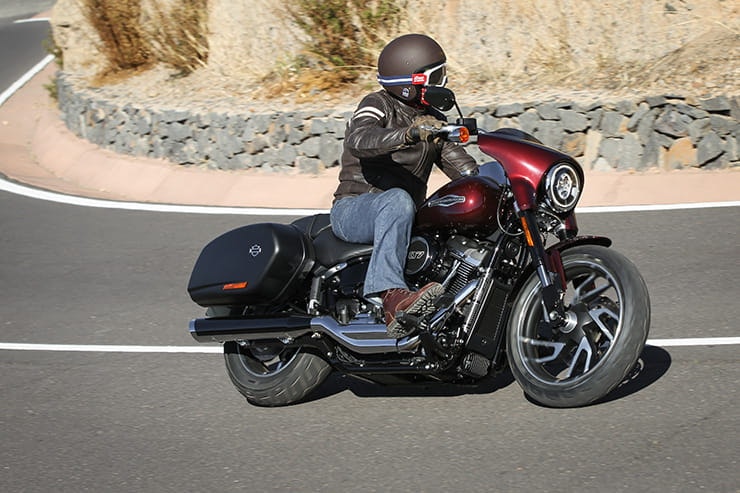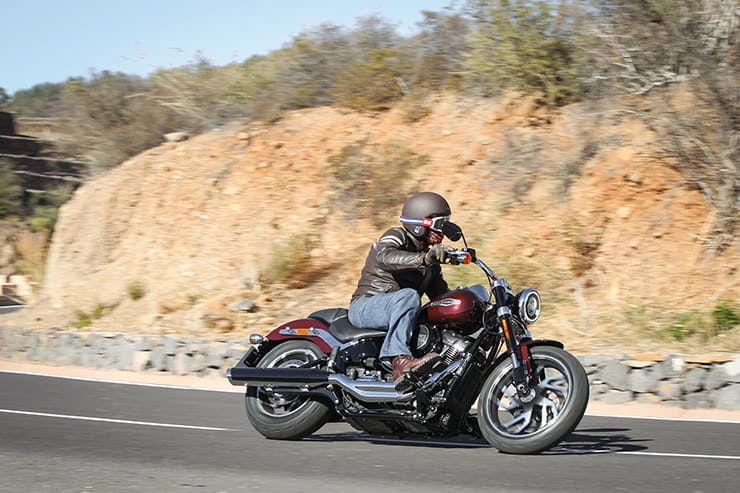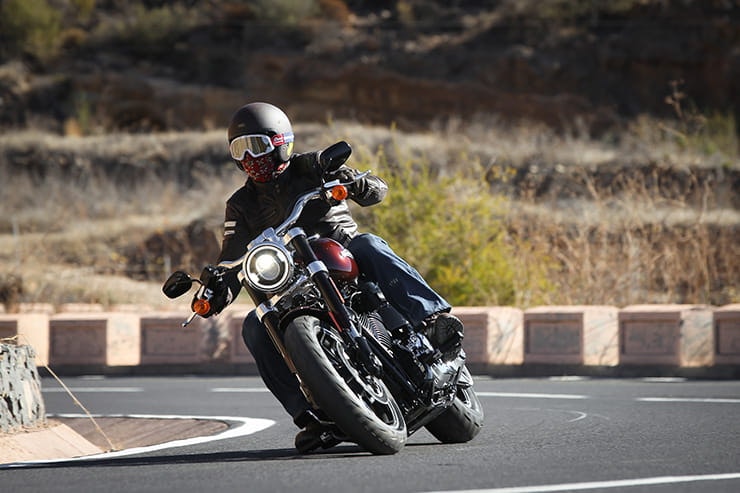Harley-Davidson Sport Glide (2018) | First ride & review
By John Milbank
Consumer Editor of Bennetts BikeSocial
24.01.2018
The 2018 Harley-Davidson Sport Glide is truly an evolution. The quality of finish and overall engineering is a jump beyond years gone by, and while there’s no denying the new Harley isn’t cheap, on closer inspection it’s clear that a lot of time and effort has been put into the details.
While heavy, it’s a bike that handles surprisingly well; gone is the ‘hinge in the middle’ cornering, and the big V-twin motor can drive this Softail out of bends and past dawdling motorists with ease. Yet it’s lost none of its character.
The Milwaukee manufacturer says it’s a bike capable of cruising, commuting and touring. It might not be the perfect winter London hack, but with its removable luggage and front fairing, low seat height and surprising performance, it’s one of the most versatile Harley-Davidsons I’ve ridden.
A quick look around the new 2018 Sport Glide
The key points of Harley-Davidson’s new cruiser
Price
In ‘vivid black’, the Sport Glide costs £14,995, including its luggage. If you want some colour, expect to page £15,345. Motorcycles are becoming increasingly expensive, not helped by the weaker pound, and while Harley has machines in its range from just £5995, the Sport Glide is something that little bit more special. Details like the precision welding where the fat handlebars reduce for the switchgear are excellent, and combined with the deep gloss paintwork, extensive use of steel (hence the weight) and well-finished engine, this is a motorcycle that feels worth a good chunk of its price tag. Whether you can personally justify the price is a different matter, but know that it’d be a machine to be proud of.
The quality of finish is clear, such as this very neat welding on the bars
Power and torque
H-D always prefers to focus on torque figures – the Sport Glide makes a very healthy 107lb-ft (145Nm) at just 3250rpm. To put that into perspective, KTM’s fire-breathing Super Duke R makes 106lb-ft (144Nm) at 7750rpm.
It’s the same torque as Harley’s Street Bob, though power is down a touch – the Bob makes 86bhp (64kW) at 3000rpm, while the new Street Glide, with its two-into-one exhaust, delivers a slightly lower 83bhp (62kW) at a fractionally later 3250rpm.
Granted, KTM’s Super Duke R makes 170bhp at 8865rpm, but to obsess about peak power figures is to miss the point of a Harley; these machines are about chilling out, and that flood of torque – which stays strong all the way to the 5650rpm rev limiter – means you can happily leave the bike is top gear on the motorway, and third or fourth on the twisties, while still being able to blast past dozy Sunday drivers.
Engine
The 1745cc Milwaukee-Eight 107 engine is arguably a thing of real beauty. Uncluttered by cables and water pipes thanks to oil cooling only around the four valves in each cylinder head, it’s probably the most authentic progression of a historic motor on the road today. And that’s not a veiled criticism – while inevitably fuel-injection has taken the place of carbs, Harley has designed a motor that’s not dressed up to replicate the engines of the past; it’s a power train that completes what feels to be one of the most honest bikes I’ve ridden in a while. It’s a Harley through and through, but it’s one that delivers modern economy; H-D claims 53mpg, which given the 18.9litre tank, could mean a range of up to 220miles.
And it’s smooth. As the engine is solidly mounted in the frame – no rubber connectors here – two balancer shafts have been used to refine things, but don’t imagine that the characterful Harley chug has gone – by reducing the idle speed, the engineers ensured this motor feels pleasing lumpy at the lights and alive at speed, but cruises smoothly at 70mph and beyond.
Despite Euro 4 limitations, the new two-into-one exhaust, with its deep-chrome trim, sounds just like you’d expect a Harley to; a deep throb at standstill, with a pleasing rumble at speed, without upsetting villagers and you pass through.
Changing gear is refined too – the Sport Glide's ’box is still relatively heavy, but it's never vague, and has lost that metallic clang as each cog is engaged.
The first service is due after 1000miles, then it’s every 5000miles or 12months, whichever comes first. The warranty is 24months with unlimited mileage.
Handling, suspension, chassis and weight
Harley’s ‘Softail’ chassis has been redesigned for the new range, and the ’Glide includes 43mm upside-down cartridge forks and a single shock that’s adjustable for preload via a remote, hydraulically-operated adjuster, tucked below the right-hand side cover.
The new machine is still no lightweight – the MiG-welded mild steel frame and swing-arm, combined with the luggage and associated racks, make for 317kg bike. I asked Jeff Myczek, engineering manager of the Street Glide, where a machine that’s claimed to have a lighter chassis can hide all that mass; “The engine is big, and has extras like the twin balancer shafts – this weight means you need the all-steel chassis to be very strong.” Ultimately, the heavy motor needs a heavy frame to carry it. On the road, most of those kilos really do disappear, but being such a low bike, it’s also surprisingly manageable to shuffle around.
Harley’s claims of this being a commuter will depend on where you work – it’s physically little bigger than any other average motorcycle, but of course it’s not as nimble as a typical street machine. It won’t upset a CB500 in town, but the luggage means you can throw your day’s gear in and ride through the week on something that’s incredibly rewarding at the weekend. Of course, those machined, cast aluminium wheels and acres of chrome won’t stay beautiful if you’re riding all year round, so consider the commuting potential a bonus, rather than a raison d'être.
A remote preload adjuster on the rear monoshock makes it easy to adjust for a pillion and luggage
The potential lean angle isn’t Harley’s best, which means it’s a way off typical street and sport-touring bikes, but despite the 27.9° clearance on the right, and 28.7° on the left, nobody had any serious issues during the launch on the twisty mountain roads of Tenerife. Jeff told me that the reduced clearance compared to the mechanically similar Low Rider’s 29.6° is down to having rubber covers on the pegs – Harley quotes the lean angle to the first point to touch down, not the absolute limit, and the sprung (at last!) pegs lift gently long before anything structural touches down, while the 34% stiffer chassis inspires confidence as you push on in tighter roads. A well ridden sports bike will of course leave it behind, but a well-ridden Sport Glide could embarrass a surprising number of average sports riders…
Our test route was very smooth, much of it being recently resurfaced – here the ’Glide was perfect. Deliberately aiming for potholes shows the limitations of any suspension that needs to carry such a mass, and sharp bumps did jar me from the seat, but overall the ride proved comfortable.
The 18inch front and 16inch cast aluminium wheels, shod in Michelin Scorcher 31 tyres, are a first for Harley factory-fit in that they’re directional, the spokes of the ‘Mantis’ wheels designed to give ‘a sense of motion even when the Sport Glide is parked.’ We didn’t come across any damp roads, but in the dry, the rubber certainly didn’t give any cause for concern.
Brakes
A single four-piston caliper bites a 300mm floating disc up front, with a two-pot sliding caliper gripping a 292mm rear disc. ABS is standard thanks to Euro 4, and while the front brake lever feels rather spongy at a standstill, in practice I found the setup to deliver plenty of power without overwhelming the forks or creating too much snatch or dive.
Luggage and touring capacity
The solid plastic, lockable panniers – with rubber seals around the inside edge – can take a combined 25.5litres of kit. Sadly you won’t be able to fit a crash helmet inside (not even an open-face), but you will easily get a weekend’s worth of gear in for you and a pillion, plus you can add a luggage rack from the huge H-D accessory catalogue.
In a genius piece of design, the panniers can be easily opened by the rider while sat on the bike. The doors only open so far, with fabric stopping anything getting caught in the pinch points around the bottom edges and preventing your gear falling out over the road: turn around, flick the lever and take what you need before shutting the box back up. Just don’t do it when you’re riding!
Jeff Myczek told me that during testing, the engineers would hold the panniers covers as they opened them, but when one of the executives tried it, the box slammed open as she grabbed the latch. Damping struts were immediately fitted, and now the side bags open with all the reverence of a quality 1980s cassette deck.
Comfort
The 680mm-high seat is wide and very comfortable; I sometimes find bikes with forward controls such as this can put too much weight on my bum, but the Street Glide seems to have good ergonomics, putting you in pleasant riding position.
At motorway speeds, there’s not a huge amount of wind protection from the fairing when you have it fitted, but despite your sail-like body position, it’s certainly not uncomfortable. Sunny weather and stunning scenery helped, but I really enjoyed cruising at 70mph on the ’Glide.
A 5.5inch-high screen is available as an optional extra if you want to extend the 1.5” one already fitted, but if you prefer the bike with no fairing, it’s as simple as popping open two clips before lifting it off. It’s a very clever piece of design, and with the steering locked, it’s virtually impossible for anyone to pinch the batwing fairing, which is a mini version of that fitted to the big Harley tourers.
Equipment
Both the head and taillights of the Sport Glide are LEDs, with only the front indicators being traditional bulbs (the rears are LEDs). The dash is a single analogue speedo, with an LCD insert that can show a choice of revs, odometer, fuel level, clock, trip and range to empty, with the gear position showing in the right of the display at all times. There’s also a USB charging outlet on the bottom left of the headstock that delivers a useful 2.4A (great for tablets and smartphones, but don’t use it to charge e-cigarettes or vapes as it’s too high for many).
The charging system can put out up to 546W at 2000rpm, so there should be enough power for your electrical accessories, and keyless ignition is standard, as is the cruise control, which is easy to use – if a touch fiddly – from the small multifunction button on the left switchgear.
The mirrors sit just above the grips, and give a good view without sticking out beyond the ends of the bars. And thanks to the reduced vibration, there’s generally very little shake to them.
Conclusion
The Sport Glide is effectively a Harley-Davidson Low Rider (£13,645 in black) with extra touring potential – Jeff Myczek told me that they’re very similar machines, which is why his team worked on both bikes. The Low Rider’s a little lighter, but the Street Glides panniers are exceptionally well designed, and leave very little trace once removed. The screen might not be the most protective, at least as standard, but it certainly creates a second persona to the bike.
The rider’s eye view is fantastic, from the highly polished bar clamps to the subtle yet elegant dash; Harley’s engineers have taken stock of the clutter of mismatched bolts that seemed to spoil the top of the forks on the bikes from a few years back, and created something that’s hugely rewarding to ride.
There’s something wonderful about cruising through stunning scenery on a Harley Davidson, and this mini-tourer takes much of what makes machines like the £19,195 Road King popular, while condensing it down into something more manageable – the result is a bike that’s all Harley, but so much more refined.
Sure, it’s not for everyone, but I can’t stress enough how I wish more people would try a Harley before deciding they’re not for them. Dealers are incredibly accommodating – why not take a trip to your nearest shop and give a Sport Glide a try? It certainly gave me one of the most enjoyable rides I’ve had in a long time…
Three things I loved about the Sport Glide…
• It makes for a brilliantly relaxed ride
• The quality of finish across the bike is excellent
• It’s got all of the Harley character I expected
Three things that I didn’t…
• The suspension can be a bit jarring over harsh bumps
• It’s heavy, but it does carry it well
• It’s not cheap, but that’s subjective
Harley-Davidson Sport Glide 2018 specification
To insure this bike, click here


